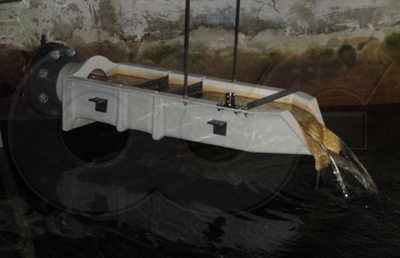Where to Install a H Flume
In selecting a site to install an H Flume there are several points to consider:
Upstream of the Flume
- Flow entering the flume MUST be sub-critical.
- The Froude number (Fr) for flow entering a flume should not exceed 0.5 and should never exceed 0.99.
- Surface turbulence may be encountered for Froude numbers above 0.5.
- For a flume to accurately measure flow, that flow must be sub-critical (Fr<0.99).
- If the approaching flow is critical (Fr = 1.0) or supercritical (Fr > 1.0), then a hydraulic jump must be formed at least 30 times the maximum anticipated head (Hmax) upstream of the entrance to the flume to slow the flow (or energy absorbers / flow straighteners must be used).
- The flow entering the flume should be smooth, tranquil, and well distributed across the channel.
The approaching channel should be straight so that the velocity profile is uniform. Surging, turbulent, or unbalanced flows must be conditioned before the flow enters the flume.
Any bends, dips, elbows, or flow junctions upstream of the flume must be sufficiently far upstream so that the flow has is well distributed and non-turbulent.
The upstream channel should be straight for at least 3 to 5 times the maximum anticipated head (Hmax).
H Flumes have been successfully used in applications where the flow rises up a uniform vertical column and then enters the flume.
Where the channel is wider than the inlet of the flume, wing walls should be formed to smoothly direct the flow into the flume.
When connecting to inlet piping, observations have shown that the pipe should be straight and without bends for at least 15 pipe diameters.
- The upstream channel should be clear of vegetative growth.
Open channel (non-full pipe) flow must be present under all flow conditions.
FLUME LOCATION
- The flume must be able to be set so that the flume is level from front-to-back and from side-to-side.
When H Flumes are installed in earthen channels and furrows, care should be taken to ensure that a stable bottom elevation is present and that the elevation does not change during dry / wet seasons or low-flow periods.
The flume must be centered in the flow stream.
The narrow opening of the flume is set downstream.
All of the flow must go through the flume – there should be no bypass.
Gwinn notes that if sediment is a concern, the approach section can be provided with a sloped floor (side-to-side) so that channelization does not occur. The slope should not exceed 1:8.
Downstream of the Flume
Flow must freely spill off the end of an H Flume.
The downstream channel should be armored (riprap) or otherwise protected so that scour does not occur.
The downstream channel must be clear of vegetative growth or the collection of debris so that flow does not back up into the flume.



